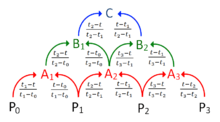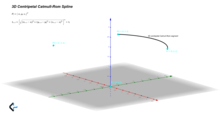Centripetal Catmull–Rom spline
In computer graphics, centripetal Catmull–Rom spline is a variant form of Catmull-Rom spline, originally formulated by Edwin Catmull and Raphael Rom,[1] which can be evaluated using a recursive algorithm proposed by Barry and Goldman.[2] It is a type of interpolating spline (a curve that goes through its control points) defined by four control points , with the curve drawn only from to .

Definition


Let denote a point. For a curve segment defined by points and knot sequence , the centripetal Catmull–Rom spline can be produced by:
where
and
in which ranges from 0 to 1 for knot parameterization, and with . For centripetal Catmull–Rom spline, the value of is . When , the resulting curve is the standard uniform Catmull–Rom spline; when , the product is a chordal Catmull–Rom spline.

Plugging into the spline equations and shows that the value of the spline curve at is . Similarly, substituting into the spline equations shows that at . This is true independent of the value of since the equation for is not needed to calculate the value of at points and .

The extension to 3D points is simply achieved by considering a generic 3D point and
Advantages
Centripetal Catmull–Rom spline has several desirable mathematical properties compared to the original and the other types of Catmull-Rom formulation.[3] First, it will not form loop or self-intersection within a curve segment. Second, cusp will never occur within a curve segment. Third, it follows the control points more tightly.

Other uses
In computer vision, centripetal Catmull-Rom spline has been used to formulate an active model for segmentation. The method is termed active spline model.[4] The model is devised on the basis of active shape model, but uses centripetal Catmull-Rom spline to join two successive points (active shape model uses simple straight line), so that the total number of points necessary to depict a shape is less. The use of centripetal Catmull-Rom spline makes the training of a shape model much simpler, and it enables a better way to edit a contour after segmentation.
Code example in Python
The following is an implementation of the Catmull–Rom spline in Python.
import numpy
import pylab as plt
def CatmullRomSpline(P0, P1, P2, P3, nPoints=100):
"""
P0, P1, P2, and P3 should be (x,y) point pairs that define the Catmull-Rom spline.
nPoints is the number of points to include in this curve segment.
"""
# Convert the points to numpy so that we can do array multiplication
P0, P1, P2, P3 = map(numpy.array, [P0, P1, P2, P3])
# Parametric constant: 0.5 for the centripetal spline, 0.0 for the uniform spline, 1.0 for the chordal spline.
alpha = 0.5
# Premultiplied power constant for the following tj() function.
alpha = alpha/2
def tj(ti, Pi, Pj):
xi, yi = Pi
xj, yj = Pj
return ((xj-xi)**2 + (yj-yi)**2)**alpha + ti
# Calculate t0 to t4
t0 = 0
t1 = tj(t0, P0, P1)
t2 = tj(t1, P1, P2)
t3 = tj(t2, P2, P3)
# Only calculate points between P1 and P2
t = numpy.linspace(t1, t2, nPoints)
# Reshape so that we can multiply by the points P0 to P3
# and get a point for each value of t.
t = t.reshape(len(t), 1)
print(t)
A1 = (t1-t)/(t1-t0)*P0 + (t-t0)/(t1-t0)*P1
A2 = (t2-t)/(t2-t1)*P1 + (t-t1)/(t2-t1)*P2
A3 = (t3-t)/(t3-t2)*P2 + (t-t2)/(t3-t2)*P3
print(A1)
print(A2)
print(A3)
B1 = (t2-t)/(t2-t0)*A1 + (t-t0)/(t2-t0)*A2
B2 = (t3-t)/(t3-t1)*A2 + (t-t1)/(t3-t1)*A3
C = (t2-t)/(t2-t1)*B1 + (t-t1)/(t2-t1)*B2
return C
def CatmullRomChain(P):
"""
Calculate Catmull–Rom for a chain of points and return the combined curve.
"""
sz = len(P)
# The curve C will contain an array of (x, y) points.
C = []
for i in range(sz-3):
c = CatmullRomSpline(P[i], P[i+1], P[i+2], P[i+3])
C.extend(c)
return C
# Define a set of points for curve to go through
Points = [[0, 1.5], [2, 2], [3, 1], [4, 0.5], [5, 1], [6, 2], [7, 3]]
# Calculate the Catmull-Rom splines through the points
c = CatmullRomChain(Points)
# Convert the Catmull-Rom curve points into x and y arrays and plot
x, y = zip(*c)
plt.plot(x, y)
# Plot the control points
px, py = zip(*Points)
plt.plot(px, py, 'or')
plt.show()
Code example in Unity C#
using UnityEngine;
using System.Collections;
using System.Collections.Generic;
public class Catmul : MonoBehaviour {
// Use the transforms of GameObjects in 3d space as your points or define array with desired points
public Transform[] points;
// Store points on the Catmull curve so we can visualize them
List<Vector2> newPoints = new List<Vector2>();
// How many points you want on the curve
uint numberOfPoints = 10;
// Parametric constant: 0.0 for the uniform spline, 0.5 for the centripetal spline, 1.0 for the chordal spline
public float alpha = 0.5f;
/////////////////////////////
void Update()
{
CatmulRom();
}
void CatmulRom()
{
newPoints.Clear();
Vector2 p0 = points[0].position; // Vector3 has an implicit conversion to Vector2
Vector2 p1 = points[1].position;
Vector2 p2 = points[2].position;
Vector2 p3 = points[3].position;
float t0 = 0.0f;
float t1 = GetT(t0, p0, p1);
float t2 = GetT(t1, p1, p2);
float t3 = GetT(t2, p2, p3);
for (float t=t1; t<t2; t+=((t2-t1)/(float)numberOfPoints))
{
Vector2 A1 = (t1-t)/(t1-t0)*p0 + (t-t0)/(t1-t0)*p1;
Vector2 A2 = (t2-t)/(t2-t1)*p1 + (t-t1)/(t2-t1)*p2;
Vector2 A3 = (t3-t)/(t3-t2)*p2 + (t-t2)/(t3-t2)*p3;
Vector2 B1 = (t2-t)/(t2-t0)*A1 + (t-t0)/(t2-t0)*A2;
Vector2 B2 = (t3-t)/(t3-t1)*A2 + (t-t1)/(t3-t1)*A3;
Vector2 C = (t2-t)/(t2-t1)*B1 + (t-t1)/(t2-t1)*B2;
newPoints.Add(C);
}
}
float GetT(float t, Vector2 p0, Vector2 p1)
{
float a = Mathf.Pow((p1.x-p0.x), 2.0f) + Mathf.Pow((p1.y-p0.y), 2.0f);
float b = Mathf.Pow(a, alpha * 0.5f);
return (b + t);
}
// Visualize the points
void OnDrawGizmos()
{
Gizmos.color = Color.red;
foreach (Vector2 temp in newPoints)
{
Vector3 pos = new Vector3(temp.x, temp.y, 0);
Gizmos.DrawSphere(pos, 0.3f);
}
}
}
For an implementation in 3D space, after converting Vector2 to Vector3 points, the first line of function GetT should be changed to this: Mathf.Pow((p1.x-p0.x), 2.0f) + Mathf.Pow((p1.y-p0.y), 2.0f) + Mathf.Pow((p1.z-p0.z), 2.0f);
See also
- Cubic Hermite splines
References
- Catmull, Edwin; Rom, Raphael (1974). "A class of local interpolating splines". In Barnhill, Robert E.; Riesenfeld, Richard F. (eds.). Computer Aided Geometric Design. pp. 317–326. doi:10.1016/B978-0-12-079050-0.50020-5. ISBN 978-0-12-079050-0.
- Barry, Phillip J.; Goldman, Ronald N. (August 1988). A recursive evaluation algorithm for a class of Catmull–Rom splines (PDF). Proceedings of the 15st Annual Conference on Computer Graphics and Interactive Techniques, SIGGRAPH 1988. 22. Association for Computing Machinery. pp. 199–204. doi:10.1145/378456.378511.
- Yuksel, Cem; Schaefer, Scott; Keyser, John (July 2011). "Parameterization and applications of Catmull-Rom curves". Computer-Aided Design. 43 (7): 747–755. CiteSeerX 10.1.1.359.9148. doi:10.1016/j.cad.2010.08.008.
- Jen Hong, Tan; Acharya, U. Rajendra (2014). "Active spline model: A shape based model-interactive segmentation" (PDF). Digital Signal Processing. 35: 64–74. arXiv:1402.6387. doi:10.1016/j.dsp.2014.09.002.
External links
- Catmull-Rom curve with no cusps and no self-intersections – implementation in Java
- Catmull-Rom curve with no cusps and no self-intersections – simplified implementation in C++
- Catmull-Rom splines – interactive generation via Python, in a Jupyter notebook